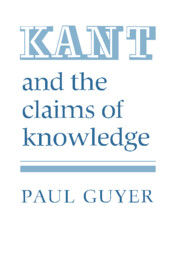Book contents
- Frontmatter
- Contents
- Acknowledgments
- Note on sources
- Introduction
- Part I Kant's early view
- Part II The transcendental deduction from 1781 to 1787
- Part III The principles of empirical knowledge
- Part IV The refutation of idealism
- Part V Transcendental idealism
- 15 Appearances and things in themselves
- 16 Transcendental idealism and the forms of intuition
- 17 Transcendental idealism and the theory of judgment
- 18 Transcendental idealism and the “Antinomy of Pure Reason”
- Afterword
- Notes
- Index of passages cited
- General index
18 - Transcendental idealism and the “Antinomy of Pure Reason”
Published online by Cambridge University Press: 09 March 2010
- Frontmatter
- Contents
- Acknowledgments
- Note on sources
- Introduction
- Part I Kant's early view
- Part II The transcendental deduction from 1781 to 1787
- Part III The principles of empirical knowledge
- Part IV The refutation of idealism
- Part V Transcendental idealism
- 15 Appearances and things in themselves
- 16 Transcendental idealism and the forms of intuition
- 17 Transcendental idealism and the theory of judgment
- 18 Transcendental idealism and the “Antinomy of Pure Reason”
- Afterword
- Notes
- Index of passages cited
- General index
Summary
Kant claims that an indirect proof of transcendental idealism is furnished by the “Antinomy of Pure Reason,” the second of the three “Dialectical Inferences of Pure Reason” (A 338 / B 396), the discussion of which comprises the bulk of the “Transcendental Dialectic” of the Critique of Pure Reason. On the assumption that things as they are in themselves really are spatial and temporal, he argues, reason is necessarily ensnared in paradoxes, certainly those concerning the upper and lower bounds of spatial and temporal extent, the infinite, and atoms, which had plagued philosophers since Zeno and which had been pressed with renewed vigor in Kant's time by Bayle and Hume, but also the paradoxes about causality and freedom, both human and divine, which had given Leibniz such trouble. But on the assumption that space and time are merely features of our representations of objects but not of the objects themselves, Kant claims, and only on this assumption, these paradoxes can be avoided. As he puts it in the preface to the second edition of the Critique, the pretension of traditional metaphysics to transcend the limits of possible experience
… yields just the experiment to check the truth of … this assessment of our a priori knowledge of reason, namely that it concerns only appearances and, on the contrary, lets the thing in itself lie, as, to be sure, real for itself but unknown by us. For that which necessarily drives us to go beyond the limits of experience and all appearances is the unconditioned, which, to complete the series of conditions for all that is conditioned, reason necessarily and with complete right demands in things in themselves. […]
- Type
- Chapter
- Information
- Kant and the Claims of Knowledge , pp. 385 - 416Publisher: Cambridge University PressPrint publication year: 1987



